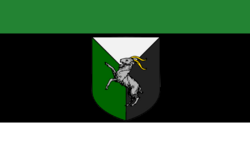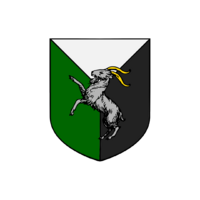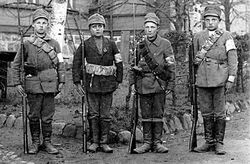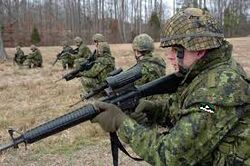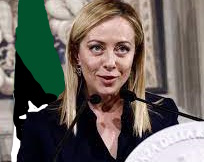Swinas
Kingdom of Swinas Königreich Swinas | |
|---|---|
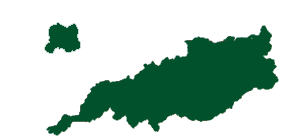 | |
| Capital | Cape Cresta City |
| National Language | German, Common |
| Ethnic groups |
|
| Demonym(s) | Swish |
| Government | Constitutional Monarchy |
• Monarch | King Friedrich III |
• Prime Minister | Amelia Norris |
| Area | |
• Total | 985,095 km2 (380,347 sq mi) |
| Population | |
• 2021 census | 42,299,153 |
| GDP (nominal) | estimate |
• Total | 448,984,350,000 |
| Currency | Swish Ram, Swish Buckling (SR, SB) |
| Driving side | right |
| Calling code | +59 |
Swinas, or, the Kingdom of Swinas is a constitutional monarchy composed of 7 autonomous districts. The capital of the Kingdom of Swinas is Cape Cresta City, where the nation was also founded under the "Duchy of Cresta" name. The nation is located in Hiraethia and is bordered by Vultesia, Wellsenfaille, and the Eldmoran Empire. The Kingdom of Swinas is a member of the Vedoti Pact and shares good relations with the Hylian Republic. The population of the Kingdom of Swinas is 42,299,153 according to a census conducted 2 years ago.
Etymology
Though the exact Etymology of Swinas is unknown, many speculate it to be related to the German word "Schwine", which means Pig.
History
Timeline:
Founding of the Duchy of Cresta --> Period of Small Wars against Duchies --> East Swinas, West Swinas, and Central Swinas are established --> Central Swinas is divided between West Swinas and East Swinas --> East Swinas wins the war against West Swinas, unifying the nation. --> Restriction of Kings Power and Democratic Reforms --> Swish Civil War --> Today
Swish Unification
The Kingdom of Swinas would not be officially established under the Swinas name until the year 1500 A.D. However, the Kingdom's Predecessor, the Duchy of Cresta, would be founded in about 1000 A.D. The nation was a key player in early Swish History and would be the duchy to officially unite Swinas. Over the span of 200 years, duchies in Swinas would slowly conquer they're neighbors until there were 3, now kingdoms in Swinas.
The Duchy of Cresta in particular had evolved into the Kingdom of East Swinas, encompassing a majority of the area's temperate land, as well as some desert land. By the year 1400 A.D. the Kingdom of East Swinas would declare war on the Kingdom of Central Swinas. The war lasted 3 years, and in the end, East Swinas came out on top. The Kingdom of West Swinas exploited the situation in the Kingdom of Central Swinas by conquering some of the Kingdom's Western Territories. At this point, the populous of both Swinas' wanted to unite into a singular Swinas. However, the other side wanted to be the one to accomplish the goal, and not the other.
A period of peace would surround the area and during that time, the Kingdom of East Swinas would conquer what is now known today as Nordinsel. This island would be useful in the coming Swish Unification War, which would happen just 60 years after the integration of the island into East Swinas. The Kingdom of West Swinas would also make moves to march westward towards the Parthenean Coast, 80 years before the Swish Unification War. By around 1500 A.D, both Kingdom's were prepared to go to war with each other and united Swinas.
On December 26th, 1494, The Kingdom of West Swinas declared war on the Kingdom of East Swinas. Though both kingdom's had similar army sizes, the island of Nordinsel would be used as a launching point for a Eastern Naval Landing on West Swinas. The Naval Invasion surprised West Swinas, and they were forced to take more defensible positions in the desert. The Kingdom of East Swinas had Arid trained men, and sent them to attack the key city of Allenschied. The battle was brutal, and the East Swish were almost kicked out of the city, but the Kingdom of East Swinas won. At this point, the Kingdom of West Swinas lost all of they're moral, and surrendered, uniting Swinas.
Transition from Absolute Monarchy into Constitutional Monarchy and Swish Civil War
Following the achievement of unifying Swinas, the nation would remain an Absolute Monarchy until 1788, when many within Swinas pushed for the creation of a constitution that limited the power of the king. After refusal of King Jonas to comply and create a constitution, his son, who was in favor of a constitution, couped his father, and the Leistungsbegrenzung came into effect. Over the course of the next 50 years, more and more democratic reforms would restrict the power of the king, until the king became a figurehead, though never being completely removed.
The king never being completely removed was a pressing issue for many Left-Wing Party's in the early 1900's. Party's such as the Swish Communist Party would advocate for the complete removal of the king, claiming that it was a shadow of the authoritarian rule Swinas was once under. This was not the only issue the Swish Communists had. In fact, this was probably one of their less important issues. The main complaint from the Swish Communist Party was that quote "greedy businessmen" controlled the country.
Eventually, rising tensions led to many Communist Militias rising up in 1921. 3 days later, the militias would unite under the People's Republic of Swinas name. The Civil War would go on to be the bloodiest conflict in Swish History. Some elements of the Civil War still impact the Kingdom of Swinas to this day. Luckily, the Kingdom of Swinas would defeat the communists, as told on the Swish Civil War page.
Following the victory of the Kingdom of Swinas, efforts were made to neutralize the remaining leftist threat in Western Swinas. The Kingdom also made small reforms to prevent another socialist uprising in the future. Reserve Forces of the Swish Civil War were called into Western Swinas to help neutralize the socialists.
Military
The Swish military, also known as the Swish Armed Forces, is responsible for the defense and security of the Swish nation. It consists of the Swish Army, Swish Navy, Swish Air Force, and the Swish National Guard. The Swish military is under the command of the Ministry of Defense, which is headed by the Defense Minister.
The Swish Armed Forces (SAF) is composed of three main branches: the Swish Army, the Swish Navy, and the Swish Air Force. The SAF is primarily tasked with defending the sovereignty and territorial integrity of Swinas, as well as maintaining peace and stability within the country.
The Swish Army is the largest branch of the SAF, with a force of approximately 250,000 active-duty personnel. Its primary responsibilities include ground-based military operations, such as land defense and counterinsurgency operations. The Swish Army is equipped with a range of modern equipment, including tanks, artillery, and infantry fighting vehicles.
The Swish Navy is responsible for defending Swinas' maritime interests, including its territorial waters and exclusive economic zone. The Swish Navy has a diverse fleet of vessels, including frigates, corvettes, and patrol boats. The Swish Navy also maintains a small number of submarines for use in special operations and intelligence gathering.
The Swish Air Force is responsible for conducting air operations in support of ground-based forces and for defending Swinas' airspace. It is equipped with a range of modern aircraft, including fighter jets, transport planes, and helicopters. The Swish Air Force also operates a number of unmanned aerial vehicles (UAVs) for use in surveillance and reconnaissance missions.
In addition to the three main branches, the SAF also includes several support branches, such as the Swish Special Forces and the Swish Military Police. The Swish Special Forces are responsible for carrying out special operations missions, such as hostage rescues and counter-terrorism operations. The Swish Military Police are responsible for maintaining discipline and enforcing military law within the SAF.
Overall, the Swish Armed Forces are considered to be a modern and capable military force, with a strong emphasis on training and readiness. The SAF has participated in a number of international peacekeeping and humanitarian missions, and maintains close ties with military forces from other countries.
Politics
Amelia Norris
During the elections of 2021, Amelia Norris, a Liberal Politician, ran for Prime Minister of the Kingdom of Swinas. She campaigned on a platform of unity and modernization, emphasizing her commitment to improving the lives of all citizens and fostering a sense of national pride. Her campaign was fierce and competitive, as she faced several strong candidates from different political parties. Despite this, Amelia Norris emerged victorious, winning a majority of the votes in the election. With her victory, she became the 3rd woman to become Prime Minister of Swinas. Her win was seen as a significant milestone in the country's political history, as it demonstrated the increasing participation and influence of women in the political sphere. Her presidency was marked by a number of significant reforms and achievements in areas such as education, healthcare, and infrastructure development.
Foreign Relations
The Kingdom of Swinas has a history of good relations with other countries, particularly with the democracies of Hylia and Trident Union, both are non-bordering countries. These countries have strong diplomatic ties, with regular high-level visits and meetings between government officials. The countries also have a strong economic partnership, with a significant amount of trade and investment taking place between them.
Swinas and Hylia have a long-standing friendship, founded on shared values such as democracy, human rights and free trade. They have cooperated on various international issues, such as peacekeeping operations and humanitarian aid, and have a strong relationship in cultural exchange.
Trident Union, being a faraway country, also has a strong relationship with the country. The two countries have a mutual defense agreement and have cooperated on various issues such as counterterrorism, drug trafficking and illegal migration. Swinas and Trident Union also have a strong economic partnership, with many Swish companies investing in Trident Union and vice versa.
Swinas also maintains cordial relations with other countries in the region and is active in regional organizations such as the Anterian Peace League. Overall, the Kingdom of Swinas is committed to promoting peace and stability in the international community and has a history of maintaining good relations with other countries. The country's foreign policy is based on the principles of non-interference, mutual respect, and cooperation with other nations.
Economy
For a brief period of time after independence in 1915, Swinas kept the Riamese currency. However, with the help from the Riamese, the country soon established its own currency, the Swish Ram, named after an old goat religion that was practiced by the indigenous people of Swinas. The Swish Ram quickly became the main currency used throughout the country, and it was widely accepted by merchants and businesses. In addition to the Swish Ram, the country also established the Swish Buckling, which was used for the paying of non-dollar increments. This system helped to ensure that the country's economy was stable and that the currency was easily accessible to all citizens. Today, the Swish Ram and the Swish Buckling are still in use and continue to play an important role in the country's economy.
Geography
Swinas has taken various measures to preserve and protect its natural resources. One of the key steps taken by the government is the establishment of national parks and nature reserves to safeguard the country's flora and fauna. Swinas has a total of 28 protected areas covering a vast area of land, including forests, wetlands, and marine ecosystems.
Furthermore, Swinas has implemented strict regulations on logging and mining to prevent deforestation and environmental degradation. The country has also invested in sustainable forestry practices, such as selective logging and reforestation programs, to ensure the long-term health of its forests. The government has also encouraged the use of alternative energy sources, such as solar and wind power, to reduce the reliance on non-renewable energy sources.
In addition, Swinas has implemented policies to reduce pollution and improve air and water quality. The government has implemented regulations on vehicle emissions, and industrial facilities are required to meet stringent environmental standards. The country has also invested in wastewater treatment facilities to ensure that wastewater is treated before being released back into the environment.
Overall, Swinas is committed to preserving and protecting its natural resources for future generations. The country's efforts to promote sustainable development have not only helped to preserve its unique ecosystems but have also created new opportunities for eco-tourism and sustainable economic growth.
Swinas is blessed with two major rivers, the Dandora and the Kishwara, which play a vital role in the country's ecosystem and economy.
The Dandora River is the longer of the two, stretching over 600 kilometers from its source in the highlands of the north to its outlet in the Talsar Sea. Along its course, the Dandora provides a lifeline for both human and animal communities, with countless towns and villages settled along its banks. The river also supports a wide range of agricultural activities, with farmers utilizing its fertile floodplains for rice, sugarcane, and other crops.
The Kishwara River, on the other hand, is relatively shorter, but no less important. It begins in the hills of the west and flows through dense forested areas and rocky terrain, creating stunning waterfalls and providing habitats for a variety of wildlife. The river is also a critical source of water for many communities in the region, supplying clean water for drinking, cooking, and washing.
Despite their importance, both rivers are facing numerous threats, including pollution from industrial activities, agricultural runoff, and urbanization. To combat these threats, the Swinas government has implemented several measures to protect the rivers and their surrounding ecosystems. These measures include the creation of protected areas and conservation zones, the establishment of monitoring programs, and the enactment of laws and regulations to control pollution and other harmful activities.
The government has also encouraged community-based initiatives to protect and conserve the rivers. For example, local organizations have been established to clean up the rivers and their surroundings, plant trees to prevent soil erosion and promote biodiversity, and educate the public about the importance of protecting these precious resources.
Overall, the Dandora and Kishwara Rivers are essential components of Swinas' natural heritage, and their protection and conservation are vital for the country's sustainable development.
